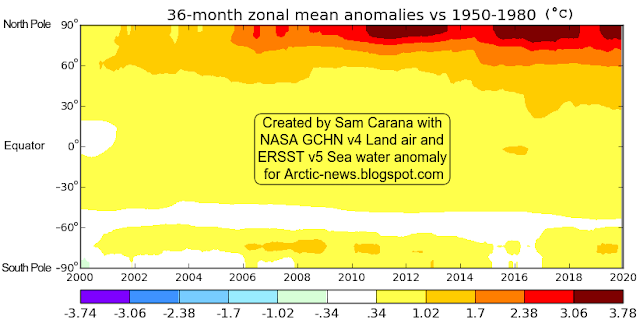 |
| [ for earlier animations, see discussions ] |
Subsequently, the NSIDC also indicated that Arctic sea ice was at record low extent for the time of year, on July 5, 2021, at 8.867 million km² (image above).
Arctic sea ice is getting very thin rapidly, threatening the latent heat tipping point to get crossed soon.
The U.S. Navy animation on the right shows Arctic sea ice thickness (in m) for the 30 days up to July 31, 2021, with eight days of forecasts included.
Arctic sea ice is getting very thin rapidly, threatening the latent heat tipping point to get crossed soon.
The U.S. Navy animation on the right shows Arctic sea ice thickness (in m) for the 30 days up to July 31, 2021, with eight days of forecasts included.
The very thin Arctic sea ice featuring on the University of Bremen image further below on the right indicates that there is now virtually no buffer left to consume further incoming heat.
Is the Buffer is gone?
 |
| [ disappearing sea ice north of Greenland ] |
Disappearance of the buffer constituted by subsurface sea ice could be measured by a threshold of most sea ice becoming less than 0.5 meter thin. By that measure, the buffer is now virtually gone, implying that virtually no further heat arriving from the Atlantic Ocean and the Pacific Ocean in the Arctic Ocean can be absorbed in the process of melting of the sea ice.
The NASA Worldview image on the right shows the sea ice on July 29, 2021, north of Greenland, where once the thickest sea ice was located.
The combination image below show forecasts for July 16 run one day earlier for Arctic sea ice in 2014 (left) and 2021 (right).
As sea ice gets thinner, ever less ocean heat gets consumed in the process of melting the subsurface ice, to the point where there is only a thin layer of ice left at the surface. While this thin layer of ice may remain at the surface for as long as air temperatures are still low enough, and this ice will still consume some heat at the bottom, at the same time it acts as a seal, preventing heat from the Arctic Ocean to enter the atmosphere.
Albedo loss, latent heat loss, storms and changes to the jet stream can add up to dramatically amplify the temperature rise of the water in the Arctic Ocean, which comes with the danger of destabilization of hydrates at its seafloor, resulting in eruption of huge amounts of methane from hydrates and opening up pathways for release of even further amounts of free gas from underneath these hydrates, as illustrated by the image below.
And while the situation in 2021 is dire, the outlook for the years beyond 2021 is that things look set to get progressively worse.
Outlook is getting worse
This situation in 2021 is the more remarkable given that we're in a La Niña period, as illustrated by the NOAA image on the right showing a forecast issued July 5, 2021, that indicates that La Niña is expected to reach a new low by the end of 2021.
Sunspots are on the rise. We were at a low point in the sunspot cycle late 2019/early 2020. As the image on the right shows, the number of sunspots is rising and can be expected to rise further as we head toward 2026, and temperatures can be expected to rise accordingly. El Niño events, according to NASA, occur roughly every two to seven years. As temperatures keep rising, ever more frequent strong El Niño events are likely to occur. NOAA anticipates the current La Niña to continue for a while, so it's likely that a strong El Niño will occur somewhere from 2023 to 2025.
According to James Hansen et al., the variation of solar irradiance from solar minimum to solar maximum is of the order of 0.25 W/m⁻².
Temperatures are currently also suppressed by sulfate cooling, and their impact is falling away as we progress with the necessary transition away from fossil fuel and biofuel, toward the use of more wind turbines and solar panels instead. Aerosols typically fall out of the atmosphere within a few weeks, so as the transition progresses, this will cause temperatures to rise over the next few years.
So, the outlook is grim. The right thing to do now is to help avoid the worst things from happening, through immediate, comprehensive and effective action as described in the Climate Plan.
Links
• National Institute of Polar Research (NIPR) in Japan
https://ads.nipr.ac.jp/vishop
• The National Snow and Ice Data Center (NSIDC) at the University of Colorado Boulder
https://nsidc.org/arcticseaicenews/charctic-interactive-sea-ice-graph
So, the outlook is grim. The right thing to do now is to help avoid the worst things from happening, through immediate, comprehensive and effective action as described in the Climate Plan.
Links
• National Institute of Polar Research (NIPR) in Japan
https://ads.nipr.ac.jp/vishop
• The National Snow and Ice Data Center (NSIDC) at the University of Colorado Boulder
https://nsidc.org/arcticseaicenews/charctic-interactive-sea-ice-graph
https://www.cpc.ncep.noaa.gov/products/analysis_monitoring/lanina/enso_evolution-status-fcsts-web.pdf
• Naval Research Laboratory of the U.S. Navy
https://www7320.nrlssc.navy.mil/GLBhycomcice1-12/arctic.html
• Latent heat
https://arctic-news.blogspot.com/p/latent-heat.html
• University of Bremen - sea ice
https://seaice.uni-bremen.de
• Aerosols
https://arctic-news.blogspot.com/p/aerosols.html
• Climate Plan
https://arctic-news.blogspot.com/p/climateplan.html
https://www7320.nrlssc.navy.mil/GLBhycomcice1-12/arctic.html
• Latent heat
https://arctic-news.blogspot.com/p/latent-heat.html
• University of Bremen - sea ice
https://seaice.uni-bremen.de
• Aerosols
https://arctic-news.blogspot.com/p/aerosols.html
• Climate Plan
https://arctic-news.blogspot.com/p/climateplan.html




























